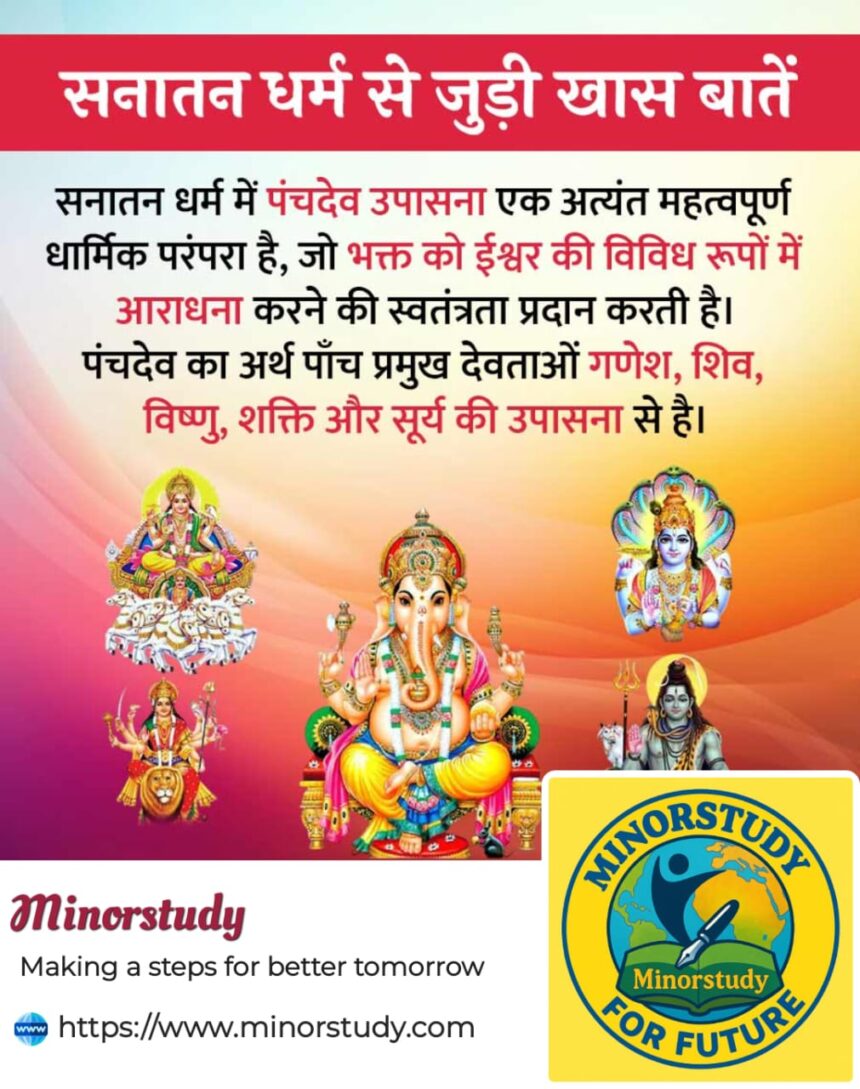🪔 5 Timeless Truths of Panchdev Upasana in Sanatan Dharma – A Powerful Path to Divine Harmony
In the vast ocean of Sanatan Dharma, there exists a sacred jewel of worship known as Panchdev Upasana. This age-old tradition reflects India’s spiritual diversity, tolerance, and profound understanding of the divine. Panchdev Upasana refers to the collective worship of five primary deities—Lord Ganesha, Lord Shiva, Lord Vishnu, Goddess Shakti, and Lord Surya (Sun).
- 🌿 What is Panchdev Upasana?
- 🕰️ Timeline & Historical Background of Panchdev Upasana
- 🛕 Origin in Smarta Tradition
- 🧾 Spiritual & Psychological Significance
- 📚 Interesting Facts About Panchdev Upasana
- ❓FAQs – Frequently Asked Questions
- Q: Is Panchdev Upasana limited to Smarta Hindus?
- Q: Can I choose only one deity?
- Q: Is it necessary to follow the Panchayatana structure?
- 🙏 Observance & Rituals of Panchdev Upasana
- 🌞 Relevance in Modern Life
- 🎉 Wishing Messages for Panchdev Upasana Observers
- 🌍 Importance in Society
- 🔚 Conclusion: A Sacred Path to Inner Wholeness
Each of these deities represents a unique cosmic force, and together, they symbolize the completeness of the divine. The freedom to choose any or all of these deities, based on personal devotion and spiritual inclination, defines the inclusive spirit of Sanatan Dharma.
In this human-friendly, deeply spiritual exploration of over 1200+ words, we will uncover the history, significance, timeline, observance, facts, FAQs, life impact, and societal importance of Panchdev Upasana.
🌿 What is Panchdev Upasana?
Panchdev Upasana literally means “Worship of Five Gods.” These are:
Ganesha – The remover of obstacles, lord of beginnings and intellect
Shiva – The transformer, yogi, and the lord of destruction and regeneration
Vishnu – The sustainer, preserver of the universe, and embodiment of Dharma
Shakti (Devi) – The divine feminine, source of power, energy, and creation
Surya (Sun) – The giver of life, light, and health
This tradition encourages balance and harmony, allowing one to connect with the divine through multiple cosmic aspects, respecting that different seekers resonate with different forms.
🕰️ Timeline & Historical Background of Panchdev Upasana
| Era | Development |
|---|---|
| Vedic Period (~1500 BCE) | Early hymns to Surya, Agni, Varuna, etc. establish multi-deity reverence |
| Upanishadic Era (~800 BCE) | Concept of “Brahman” includes multiple forms of divinity |
| Puranic Period (~300–1000 CE) | Rise of structured worship of Vishnu, Shiva, Devi, Surya, Ganesha |
| Gupta Era (~4th–6th century CE) | Panchayatana Puja system is formalized by Adi Shankaracharya |
| Medieval Period | Panchdev worship becomes mainstream across temples and homes |
| Modern Times | Continues as core practice in Smarta tradition and others |
🛕 Origin in Smarta Tradition
Panchdev Upasana was especially systematized by Adi Shankaracharya, the great 8th-century philosopher and saint who established the Smarta Sampradaya. His vision was to unify Hindus under a non-sectarian approach.
He introduced the Panchayatana Puja system—placing five idols (each representing one Dev) in a specific geometrical arrangement. The sixth spot in the center is often left for Ishta Devata, the personal god of the devotee.
🧾 Spiritual & Psychological Significance
Each deity in Panchdev Upasana is not just a religious symbol but a manifestation of spiritual psychology:
| Deity | Symbolizes | Inner Meaning |
|---|---|---|
| Ganesha | Wisdom & New Beginnings | Control over ego & intellect |
| Shiva | Destruction & Meditation | Inner silence, letting go |
| Vishnu | Protection & Dharma | Righteousness and balance |
| Shakti | Power & Fertility | Creative energy, compassion |
| Surya | Light & Knowledge | Enlightenment and vitality |
By honoring all five, the seeker acknowledges the full spectrum of existence—matter and spirit, light and darkness, action and stillness.
📚 Interesting Facts About Panchdev Upasana
The term “Panchdev” is found in multiple Puranas and Smriti texts.
Adi Shankaracharya promoted it to reduce sectarian divides.
The Panchayatana Puja Mandala is symbolic of the universe.
Many temples in India, especially South India, follow this system.
It allows freedom of worship without enforcing one belief system.
❓FAQs – Frequently Asked Questions
Q: Is Panchdev Upasana limited to Smarta Hindus?
A: No. While prominent in Smarta tradition, many Hindus across sects worship these deities regularly, especially in festivals and family traditions.
Q: Can I choose only one deity?
A: Absolutely. The uniqueness of Sanatan Dharma lies in freedom. You can focus on one or worship all. It’s your connection with the divine that matters most.
Q: Is it necessary to follow the Panchayatana structure?
A: It’s helpful but not compulsory. Devotion is the essence. Even keeping five photos together and offering flowers or prayers suffices.
🙏 Observance & Rituals of Panchdev Upasana
Daily Puja at home or temple with incense, lamps, and chanting.
Panchayatana Puja in a square arrangement (Vastu-aligned).
Festivals like Ganesh Chaturthi, Maha Shivratri, Navratri, Vishnu Jayanti, Surya Saptami are individually celebrated for each Dev.
In South India, Kalasa Puja includes all five Devatas in temple rituals.
🌞 Relevance in Modern Life
In today’s fragmented world, Panchdev Upasana teaches us:
Inclusivity – All forms of divine are valid.
Balance – Honor masculine and feminine energies equally.
Connection – You are not limited to one path.
Respect for Diversity – Your truth can be different, yet still sacred.
It reduces ego-driven religious superiority and fosters universal spirituality.
🎉 Wishing Messages for Panchdev Upasana Observers
“May the combined blessings of Panchdev illuminate your life with wisdom, strength, and love!”
“Let Shiva’s depth, Vishnu’s grace, Shakti’s energy, Ganesha’s intellect, and Surya’s light bless every moment of your life.”
“In Panchdev Upasana, find your path to peace, purpose, and divine unity.”
🌍 Importance in Society
🔹 Culturally:
Promotes unity in diversity in religious thought
Preserves ancient Vedic wisdom
Encourages family rituals and bonding
🔹 Philosophically:
Nurtures a non-dualistic worldview
Fosters mental well-being and emotional grounding
Emphasizes harmony between different belief systems
🔚 Conclusion: A Sacred Path to Inner Wholeness
Panchdev Upasana is not just a ritual—it’s a living tradition, a unifying philosophy, and a sacred practice that honors the richness of Sanatan Dharma. In an age of division and dualism, this practice reminds us that truth has many forms and that all roads ultimately lead to the same divine center.
When you light a lamp before Ganesha, or chant Vishnu Sahasranama, or meditate on Shiva, you are not moving away from truth but walking toward it—through your own unique door.
In embracing the Panchdev, you embrace your whole self—the thinker, the feeler, the doer, the dreamer, and the eternal soul.








